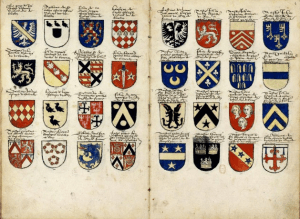
Queen Guinevere as mistress of a court of love, exchanging glances with Sir Lancelot, by Herbert James Draper (c. 1890).
On Valentine’s Day of 1401, the French Court experienced what might be called the largest court ever assembled.
But this was no ordinary court. Founded by King Charles VI and two of his dukes, this court was focused on honoring one thing: women and how they made men feel. It was the Court Amoureuse, or “Love Court,” and it sought to celebrate the feelings that courtly ladies inspired by encouraging poetry, song, and oratorical contests. In so doing, it hoped to restore the honorable, courteous, and chivalrous attitude towards ladies.
The Court Amoureuse was based on a familiar model: the “courts of love.” This was a medieval courtly game during which judicial-like organizations were formed to discuss questions of law and love. You might have heard of the most famous of these courts, which was founded by Eleanor of Aquitaine at Poitiers in 1170 and 1173. But the Court Amoureuse – founded over 200 years later – seems to outdo Eleanor’s in terms of size.
This court had over 700 members, which were divided into sections based on social class: the Grand Conservatives, the Conservatives, The Prince of Love, and Ministers, Auditors, Knights of Honor Counsels, Knights Treasurers, Great Hunters, Knights of Charters and Registers, Squires of Love, Masters of Petitions, Secretaries, Substitutes of the Attorney General of the Court, and Hunters. Each group had its own attributes and was associated with a specific class of society, from the king to the lower clergy. For example, the Grand Conservatives were King Charles VI and the Dukes of Burgundy and Bourbon: the three highest-ranking members of the court. What is unique about this structure is that it united members of the upper and lower nobility with those of the increasingly powerful bourgeoisie, secular leaders and clergy.

Coats of arms from the members of the Court Amoureuse, as described by Jacques Le Boucq (1520-73). Currently held by the Bibliotheque nationale de France (National Library of France).
Formed in 1401, the Court Amoureuse held its first meeting on Valentine’s Day at the Hotel d’Artois. The day included a mass service, a reading of their charter in public, dinner with “happy and loving conversation,” and contests of poetry and love ballads. The court held additional meetings throughout the year, including “a joyous literary festival” on the first Sunday of each month and sessions during festivals in honor of the Virgin Mary.
What makes the Court Amoureuse interesting – at least to me – is that it was held during a time when France was plagued by unrelenting civil war and plague. Was this a way for the nobility to forget about the troubles they faced?
I also find “courts of love” fascinating because they are organizations founded by men to ensure that women were treated well. In a time when domestic and gender-based violence are rising in our public consciousness, it perhaps is a question we must consider both about history and ourselves: Do such courts of love help to foster greater respect for women, or do they further regulate women to a role as purely objects of affection and sexual attraction?
Did chivalry contribute to the perpetuation of patriarchal society – and its most negative outcomes – or did it serve as a reminder that women were deserving of respect and admiration?
Should we emulate courts of love and their focus on treating women “well” – or should we further distance ourselves from “chivalrous” behavior (much of which occurs on Valentine’s Day) in an effort to foster greater respect for girls and women all year long?
It’s a curious question for curious times.
– Tiffany Rhoades
Program Developer
Girl Museum, Inc.
